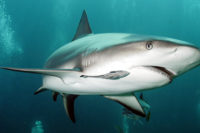WEST LAFAYETTE, IN—Oysters build extensive reef communities by cementing to one another early in their lives. Scientists have known they secrete an adhesive for this purpose, but new research shows the glue they make as larvae and the glue they make as juveniles are different substances.
When microscopic oyster larvae decide where they want to live forever, they stick out a tiny foot and attach to a surface. Within minutes to hours, they start laying down an adhesive. In terms of chemistry, this is an organic, hydrated material.
“It’s basically a premade goop that they have ready to go,” said Jonathan Wilker, Ph.D., a professor of chemistry and materials engineering at Purdue University. “When they find a place they want to stay, that is where they shoot it onto.”
Within 48 hours of putting their foot down, baby oysters start transitioning from larvae to juveniles. This progression is marked by the secretion of a new adhesive, which comes from between the oyster’s shells.
After the first two days, oysters continued to grow and secrete this second-stage glue, which is a composite of organic and inorganic substances. It’s actually 85 percent calcium carbonate, which is what oyster shells are made of. This is the glue that binds oysters together for life.
By analyzing oyster adhesion throughout their various life stages, Wilker’s team hopes to provide insights for the design of new industrial adhesives.






